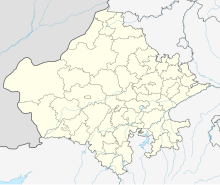Rebellion of Jatwan
This article has multiple issues. Please help improve it or discuss these issues on the talk page. (Learn how and when to remove these messages)
|
| Rebellion of Jatwan | |||||||
|---|---|---|---|---|---|---|---|
| Part of Indian campaigns of Muhammad of Ghor | |||||||
 Hansi fort which was besieged by Jatwan | |||||||
| |||||||
| Belligerents | |||||||
| Ghurid dynasty | Jatwan | ||||||
| Commanders and leaders | |||||||
| Qutb ud-Din Aibak | Jatwan † | ||||||
Location of Bagar | |||||||
The Rebellion of Jatwan[1] was a revolt staged by Jatwan, a subordinate of Prithviraj Chauhan of Chauhan dynasty aganist the Ghurid empire in 1192 CE. The Ghurids defeated the rebel forces and Jatwan was killed in the battle.[2][3][4][5]
In 1192, soon after the second battle of Tarain, Jatwan, a subordinate of Prithviraj Chauhan, besieged Hansi, which came under Ghurid rule after the battle. After the defeat of Prithviraj in 1192 A.D., Jatwan raised the standard of revolt, and besieged the Muslim commander Nasrat Uddin at Hansi. On receiving this news Qutb-ud-din marched twelve farsakhs, i.e., about 40 miles during one night. Jatwan raised the siege of Hansi and prepared for an obstinate conflict. "The armies attacked each other" says the author of Taj-ul-Maasir "like two hills of steel, and the field of battle [on the borders of the Bager country] became tulip-dyed with the blood of warriors ... Jatwan had his standards of God-plurality and ensigns of perdition lowered by the hand of power".
References
- ^ Siddiqi, Iqtidar Husain (2010). Indo-Persian Historiography Up to the Thirteenth Century. Primus Books. p. 43. ISBN 978-81-908918-0-6.
- ^ Jain, Meenakshi (2011-01-01). THE INDIA THEY SAW (VOL-2): Bestseller Book by Meenakshi Jain: THE INDIA THEY SAW (VOL-2). Prabhat Prakashan. p. 240. ISBN 978-81-8430-107-6.
- ^ Elliot, Sir Henry Miers (1869). The History of India, as Told by Its Own Historians: The Muhammadean Period; the Posthumous Papers of H. M. Elliot. Akbar Badauni. Susil Gupta (India) Private. pp. 71–72.
- ^ Srivastava, Ashok Kumar (1990). Disintegration of North Indian Hindu States, C. 1175-1320 A.D. Purvanchal Prakashan. pp. 87–89.
- ^ Srivastava, Ashok Kumar (1972). The Life and Times of Kutb-ud-din Aibak. Govind Satish Prakashan. p. 106.


